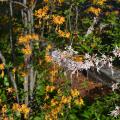Site Selection and soil preparation for perennials
Consider the site before selecting your plants. Although many perennials, such as ferns, tolerate heavy shade, most perennial plants require abundant sunshine. Air circulation is important for avoiding diseases; stagnant, warm, and humid air creates ideal conditions for diseases. Perennial plants also require properly prepared soil, and a few have specific drainage and fertility requirements.
Soil preparation for perennials is similar to soil preparation for annuals. However, you should devote some special attention to perennial bed preparation, because plants may occupy the site for several years with little opportunity to correct any problems. When possible, add sand and organic matter such as bark, peat, or compost to soils well ahead of planting time.
A layer of organic matter 3 or 4 inches deep, worked into the soil a shovel's depth, is usually adequate. Since different types of organic matter work and decompose at different rates in the soil, it is best to use a little of two or three kinds of organic matter than a lot of just one.
Soil testing provides specific recommendations for fertilizer and lime needs. Since lime lasts for several years depending on the type used, never add lime without a soil test. Many fertilizers, such as phosphorus, are best applied and mixed into soils before planting. Perennials need a balance of several nutrients, including nitrogen, phosphorous, and potash; most garden supply stores carry a wide variety of fertilizer mixes. Keep in mind that phosphorus, including that found in bone meal, lasts for several years and need not be applied regularly.
Publications
News
Next up in my series celebrating April as Native Plant Month are those that thrive in sunny landscapes.
One of my favorites is yarrow, a tough, drought-tolerant perennial that does especially well in full sun and well-drained soil. Once established, yarrow is very low maintenance and even thrives in poor, sandy or rocky soils.
I often get asked which plants thrive in the shade, so today I want to discuss some native selections that do just that.
April is Native Plant Month, making it the perfect time to celebrate the beauty and importance of native species. Native azalea is one of my favorites, and it is currently putting on a spectacular show.
Throughout this month, I’ll highlight other native plants that thrive in our region.









